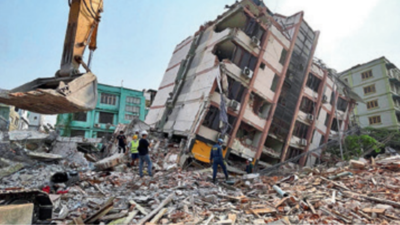- News
- City News
- dehradun News
- Myanmar quake that killed over 2k signals looming Himalayan threat, warn experts
Trending
Myanmar quake that killed over 2k signals looming Himalayan threat, warn experts
The catastrophic earthquake in Myanmar, which claimed over 2,000 lives, underscores the even greater seismic threat facing the Himalayan region. Experts warn of the potential for an even more destructive quake in densely populated areas due to the relentless collision of tectonic plates.
DEHRADUN: The catastrophic earthquake that rocked Myanmar, claiming over 2,000 lives, bears striking geological parallels with the seismic threats looming over the Himalayan region - a zone experts describe as "far more active and perilously vulnerable". Senior seismologists warn that while the Myanmar disaster offers a grim lesson, "the Himalayas face an even greater risk", with densely populated areas hanging in the balance.
The Myanmar quake, registering a magnitude of 7.7, originated along the Sagaing Fault, a tectonic boundary on the eastern edge of the Indian Plate where it grinds against the Sunda Plate. In contrast, the Himalayan fault system - driven by the Main Himalayan Thrust (MHT) and Himalayan Frontal Thrust (HFT) - is fuelled by the relentless head-on collision between the Indian and Eurasian plates.
"The Himalayas' susceptibility to major earthquakes is much higher than that of the Sagaing Fault region. If a 7.7-magnitude quake like Myanmar's struck the Garhwal-Kumaon Himalayas, its effects could ripple as far as Gujarat - over 1,500 km away," Vineet Gahlaut, director of the Dehradun-based Wadia Institute of Himalayan Geology, told TOI.
He added that the Myanmar quake's reach extended up to 1,000 km, rattling buildings up to Bangkok.
Yet, the differences are telling. The Sagaing Fault's tremors stem from the lateral sliding of tectonic plates, a process known as strike-slip faulting. In the Himalayas, however, the plates collide head-on, thrusting massive energy into a complex network of faults - a recipe for far more destructive quakes.
Speaking about the frequent warnings of a "big earthquake" in the Himalayas, Gahlaut, who is also the former director of the National Centre for Seismology in Delhi, said, "Our most conservative estimates suggest the region hasn't seen a quake of 8 or higher magnitude in over 500 years. Tectonic strain has been building relentlessly, making it overdue for a major rupture - though pinpointing when it will occur is impossible."
This pent-up energy, accumulated as the Indian Plate plunges beneath the Eurasian Plate at a rate of about 4-5 cm annually, heightens the stakes for millions living in the Himalayan foothills and beyond, experts said.
Senior geologist Piyoosh Rautela pointed out that seismic activity in the Himalayan region is continuous. "The recent earthquake in Myanmar is a stark reminder of the Himalayan region's high seismic vulnerability. Given the ongoing tectonic activity, even moderate tremors could indicate the potential for a larger event. It is crucial to prioritise preparedness and avoid excessive development in seismically-active zones," he said.
Historical records paint a sobering picture. The last "great" earthquake in the Uttarakhand Himalayas, with a magnitude of 8 or higher, struck in 1344.
More recent quakes - like the 1803 tremor confined to Devprayag and Srinagar, the 6.8-magnitude 1991 Uttarkashi quake (over 700 deaths), and the 6.6-magnitude 1999 Chamoli quake (over 100 deaths) - pale in comparison but hint at the region's restless geology.
"These smaller events, like the ones we witness more frequently, release only a fraction of the stored energy," Gahlaut added, stressing that adhering to building regulations and raising public awareness are the only viable solutions given the region's vulnerabilities.

About the Author
Gaurav TalwarEnd of Article
Follow Us On Social Media









